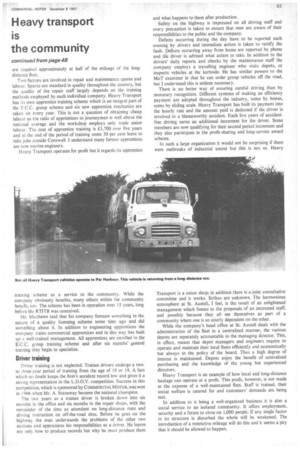H eavy transport
Page 55

If you've noticed an error in this article please click here to report it so we can fix it.
is the community
continued from page 48 are required approximately at half of the mileage of the longdistance fleet.
Two factors are involved in repair and maintenance spares and labour. Spares are standard in quality throughout the country, but the quality of the repair staff largely depends on the training methods employed by each individual company. Heavy Transport has its own apprentice training scheme which is an integral part of the E.C.C. group scheme and six new apprentice mechanics are taken on every year. This is not a question of obtaining cheap labour as the ratio of apprentices to journeymen is well above the national average and the workshop employs only trade union labour. The cost of apprentice training is £1,700 over five years and at the end of the period of training some 50 per cent leave to take jobs outside Cornwall. I understand many former apprentices are now marine engineers.
Heavy Transport operates for profit but it regards its apprentice
and what happens to them after production.
Safety on the highway is impressed on all driving staff and every precaution is taken to ensure that men are aware of their responsibilities to the public and the company.
Defects occurring during the day have to be reported each evening by drivers and immediate action is taken to rectify the fault. Defects occurring away from home are reported by phone and die driver is advised what action to take. In addition to the drivers' daily reports and checks by the maintenance staff the company employs a travelling engineer who visits depots, or inspects vehicles at the kerbside. He has similar powers to the MoT examiner in that he can order group vehicles off the road, but I understand this is seldom necessary.
There is no better way of ensuring careful driving than by monetary recognition. Different systems of making an efficiency payment are adopted throughout the industry, some by bonus, some by sliding scale. Heavy Transport has built its payment into the hourly rate and the amount paid is deducted if the driver is involved in a blameworthy accident. Each five years of accidentfree driving earns an additional increment for the driver. Some members are now qualifying for their second period increment and they also participate in the profit-sharing and long-service award scheme.
In such a large organization it would not be surprising if there were outbreaks of industrial unrest but this is not so. Heavy training scheme as a service to the community. While the company obviously benefits, many others within the community benefit, too. The scheme has been in operation over 15 years, long before the RTITB was conceived.
Mr. Matthews said that his company foresaw something in the nature of a quality licensing scheme some time ago and did something about it. In addition to engineering apprentices the company trains commercial apprentices and in this way has built up a well-trained management. All apprentices are enrolled in the E.C.C. group training scheme and after six months' general training they begin to specialize.
Driver training Driver training is not neglected. Trainee drivers undergo a twoto three-year period of training from the age of 18 or 19. A fact which no doubt keeps the firm's accident record low and gives it a strong representation in the L.D.O.Y. competition. Success in this competition, which is sponsored by COMMERCIAL MOTOR, was won in 1966 when Mr. A. Stanaway became the national champion.
The two years as a trainee driver is broken down into six months in the office and six months in the repair shops, with the remainder of the time as attendant on long-distance runs and driving instruction on off-the-road sites. Before he goes on the highway the man understands the problems of the other two sections and appreciates his responsibilities as a driver. He learns not only how to produce records but why he must produce them
Transport is a union shop; in addition there is a joint consultative committee and it works. Strikes are unknown. The harmonious atmosphere at St. Austell, I feel, is the result of an enlightened management which listens to the proposals of an interested staff, and possibly because they all see themselves as part of a community where one is so utterly dependent on the other.
While the company's head office at St. Austell deals with the administration of the fleet in a centralized manner, the various depots are separately accountable to the managing director. This, in effect, means that depot managers and engineers require to operate and maintain their local fleets efficiently and economically but always to the policy of the board. Thus a high degree of interest is maintained. Depots enjoy the benefit of centralized purchasing and the knowledge of the young but experienced directors.
Heavy Transport is an example of how local and long-distance haulage can operate at a profit. This profit, however, is not made at the expense of a well-maintained fleet. Staff is trained, their social welfare is catered for and customers' demands are being met.
In addition to it being a well-organized business it is also a social service to an isolated community. It offers employment, security and a future to close on 1,000 people: If any single factor in its structure is disturbed the whole will be weakened. The introduction of a restrictive mileage will do this and it seems a pity that it should be allowed to happen.








































































































